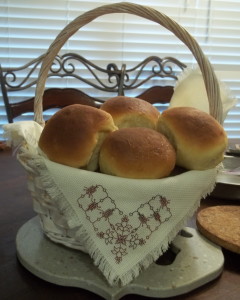
This week is going to be another compare-and-contrast. I’ve got a pair of recipes for this bread, one that I’ve made pretty successfully a couple of times and one that this will be the maiden voyage for. The first method is one from Facebook and the other is from BBA.
Hawaiian sweet bread is, well, sweet. And bread. And soft. And pillowy. And gorgeous. It is also a favorite of my ‘other momma.’ My mom and her older sister live together, being ‘two old widder women’ as my aunt says. The two of them shamelessly mother the entire combined brood of kids and grandkids. I try to make yummy things for them to take over when I’m able to go visit.
According to Aunt T, the Facebook recipe freezes nicely and so can be divided up into smaller portions to be eaten over a longer period of time. The BBA recipe calls for being divided into two loaves, but that didn’t quite work out the way I wanted, thanks to yet another unseasonale cold snap.
The Facebook recipe starts out with all the wet ingredients together, starting with beating together the eggs. In truth, both of these recipes start out a lot like cake. Probably not surprising with the amount of enrichment going on.
After you’ve got the wet ingredients mixed together, you add in three cups of the flour and mix into a thick batter, then add another three cups. Once it becomes un-mixable by spoon (and it always does for me), you start in using your hands.
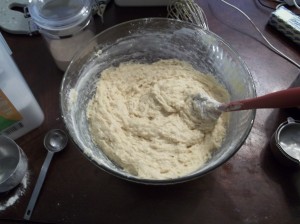
Usually, I need to add a little extra flour to get the dough to stop being sticky. Once you’ve got a nice ball of dough, you cover it and set it aside for an hour or so to double. It usually does this pretty dramatically and fairly quickly. The sugar and pineapple juice seem to give the wee yeasties lots to nom on.
While it’s rising, butter a couple of dishes. I have a trick for buttering bakeware that I got from my mom. We use, well, kind of a lot of butter in this house. When it’s not homemade, we save what we call ‘butter skins,’ which is really just the wrappers from sticks of butter. Use these to smear around in any dishes you need to butter. Voila, reduce, reuse, recycle at work!
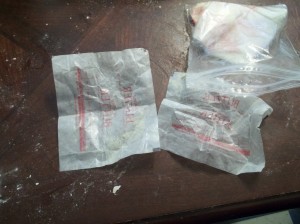
This recipe tends to make enough to fill one of my big Pyrex baking dishes with rolls with enough left over to either make a loaf or another smaller batch of rolls. The plan for these was to have some pulled pork and use them as sandwich rolls, so I did the big dish full of normal sized rolls and made five larger ones to fit in the smaller dish.
While the first batch was doing its initial rise, I started in on the BBA recipe. This one is supposed to make enough dough for two loaves, but something went wrong. I’m going to try again because the pineapple juice in the original recipe seems to trigger tummy issues in C, who eats more of my bread than anyone else. To get that sweet/fruity flavor, the BBA recipe uses lemon and orange extracts. It starts with a sponge, which is all the yeast, some of the flour and some of the wet ingredients. It came out just like it was supposed to, like a smooth pancake batter. I covered it with plastic wrap and set it aside.
While the sponge was bubbling away, the Facebook bread finished its initial rise. I turned it out onto the counter (or the pasty mat in my case) and kneaded another half-cup or so of flour. This usually goes pretty quickly, but this batch wasn’t picking up and hydrating the flour as quickly as normal, so it took a little more work to get all the flour in. The dough is usually soft and easily workable and not overly tacky.
Once it’s got the right texture, I use one of my plastic dough scrapers to cut off small pieces of dough and form them into rolls. I leave a little space between the rolls as I put them into dishes because the second rise will usually expand them so that they fill all the extra space, and what isn’t filled by that is usually filled by oven spring.
The rolls get covered again and set aside for another hour or so to proof. I start preheating the oven at this point. I use my stones because they’re pretty much always in the oven, but they aren’t needful. And neither is steam, since you want a soft crust and not a crackling one.
By this time, the sponge was done doing its sponge-y thing. It was all bubbly and had doubled, just like it was supposed to.
Once the sponge is risen, you start in on the dough. It starts out like cake, too, with creaming together sugar and butter and shortening. I used the KitchenAid for this because that cold snap was playing a little bit of havoc with my hands. Eggs and extracts go in once everything is creamed together, and it comes out like more batter.
Then in goes the rest of the flour and enough water to make a soft, rich dough. I’m going to double-check my amounts next time because this just didn’t seem like enough dough. Pretty, but just not enough.
It went into the oiled bowl and got covered and set somewhere warm to rise. Which it didn’t do. I gave it two hours and it just didn’t seem to have much oomph to it. This is where I knew Something Wasn’t Right.
It said to divide the dough in half and form two boules that were supposed to both go into oiled cake pans for the final proofing stage. There just wasn’t enough, so I made one boule and put it into a pan. Thinking maybe it had just been too cold, I turned to the redneck proofing box and put the boule into the microwave with a mug of hot water for the final proofing.
In the meantime, the first batch of rolls had come out of the oven. They also didn’t rise like normal. Usually, this recipe handily fills that big Pyrex dish with three less rolls in it, but you can see that there’s some room left.
The smaller dish rose a little better and the rolls are a little larger. We used these as sandwich buns for pulled pork the next day and from the speed with which they disappeared, they were pretty tasty.
Once they were done, I pulled the BBA dough out of the microwave. According to the recipe, this was supposed to be enough dough to overfill two of these pans, but this is all the more rise I got out of this one.
I’m definitely going to try this again sometime, but on a warmer day. It felt OK to me in the kitchen, but everyone else told me it felt exceptionally cold. In any case, this got an egg wash and went into the oven. It came out really dense, but it smelled lovely and the flavor was declared to be pretty decent.
So, Hawaiian bread. It’s a good, tender dinner roll. My plan is to make this the next time there’s a family potluck. Or, really, any kind of potluck. If anyone out there has an idea why the rise didn’t happen really at all, let me know.
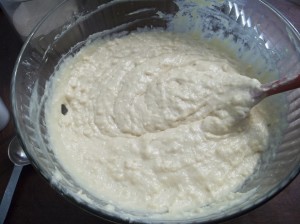
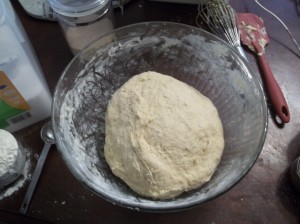


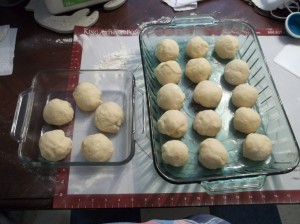


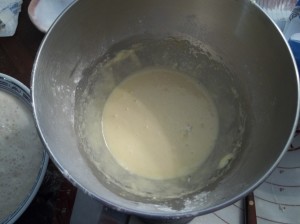


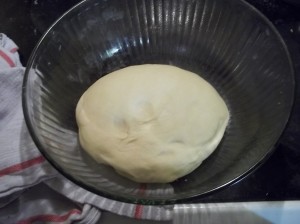
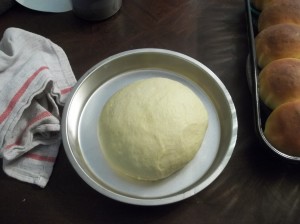


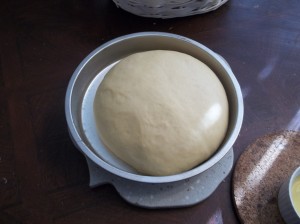
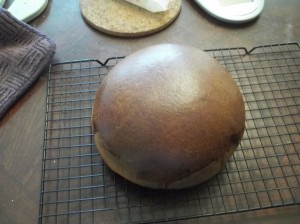
What’s “oven spring,” please? Also, “proofing” is the dough rising, right?
Oven spring is the additional rise you get out of a loaf of bread when you put it in the hot oven. The bread ‘springs’ up. Usually that’s when you get the nice domed look. And, yes, proofing is another word for rising, though it’s usually used for the second part of the rise after you’ve shaped it into whatever shape you want for the final product.